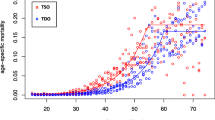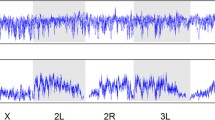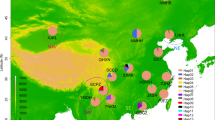Abstract
The impact of genetic drift in population divergence can be elucidated using replicated laboratory experiments. In the present study we used microsatellite loci to study the genetic variability and differentiation of laboratory populations of Drosophila subobscura derived from a common ancestral natural population after 49 generations in the laboratory. We found substantial genetic variability in all our populations. The high levels of genetic variability, similar across replicated populations, suggest that careful maintenance procedures can efficiently reduce the loss of genetic variability in captive populations undergoing adaptation, even without applying active management procedures with conservation purposes, in organisms that generate a high number of offspring such as Drosophila. Nevertheless, there was a significant genetic differentiation between replicated populations. This shows the importance of genetic drift, acting through changes in allele frequencies among populations, even when major changes in the degree of genetic diversity in each population are not involved.

Similar content being viewed by others
References
Beaumont MA, Balding DJ (2004) Identifying adaptive genetic divergence among populations from genome scans. Mol Ecol 13:969–980
Beaumont MA, Nichols RA (1996) Evaluating loci for use in the genetic analysis of population structure. Proc R Soc Lond B 263:1619–1626. Fdist2 softare available from http://www.rubic.rdg.ac.uk/~mab/software.html)
Briscoe DA, Malpica JM, Robertson A et al (1992) Rapid loss of genetic variation in large captive populations of Drosophila flies: implications for the genetic management of captive populations. Conserv Biol 6:416–425
Caballero A (1994) Developments in the prediction of effective population size. Heredity 73:657–679
Caballero A, Toro MA (2000) Interrelations between effective population size and other pedigree tools for the management of conserved populations. Genet Res 75:331–343
Carreras-Carbonell J, Macpherson E, Pascual M (2006) Population structure within and between subspecies of the Mediterranean triplefin fish Tripterygion delaisi revealed by highly polymorphic microsatellite loci. Mol Ecol 15:3527–3539
Chippindale AK (2006) Experimental Evolution. In: Fox C, Wolf J (eds) Evolutionary genetics: concepts and case studies. Oxford University Press, London, pp 482–501
Cornuet JM, Luikart G (1996) Description and power analysis of two tests for inferring recent population bottlenecks from allele frequency data. Genetics 144:2001–2014
Crawford NG (2009) SMOGD: Software for the measurement of genetic diversity. Mol Ecol Resou 10:556–557. Available from http://www.ngcrawford.com/django/jost/
Crow JF, Kimura M (1970) An introduction to population genetic theory. Harper & Row, New York
Dieringer D, Schlötterer C (2003) Microsatellite analyser (MSA): a platform independent analysis tool for large microsatellite data sets. Mol Ecol Notes 3:167–169
England PR, Osler GHR, Woodworth LM et al (2003) Effects of intense versus diffuse population bottlenecks on microsatellite genetic diversity and evolutionary potential. Conserv Genet 4:595–604
Excoffier L, Laval G, and Schneider S (2005) Arlequin ver. 3.0: an integrated software package for population genetics data analysis. Evolutionary Bioinformatics Online 1:47–50. Available at http://cmpg.unibe.ch/software/arlequin3/
Falconer DS, Mackay TFC (1996) Introduction to quantitative genetics. Longman, Harlow
Frankham R (1995) Effective population size/adult population size ratios in wildlife: a review. Genet Res 66:95–107
Frankham R (2005) Stress and adaptation in conservation genetics. J Evol Biol 18:750–755
Frankham R, Manning H, Margan SH, Briscoe DA (2000) Does equalisation of family sizes reduce genetic adaptation to captivity? Anim Conserv 3:357–363
Frankham R, Ballou JD, Briscoe DA (2002) Introduction to conservation genetics. Cambridge University Press, Cambridge
Garza JC, Williamson E (2001) Detection of reduction in population size using data from microsatellite DNA. Mol Ecol 10:305–318
Gilligan DM, Frankham R (2003) Dynamics of genetic adaptation to captivity. Conserv Genet 4:189–197
Gloor GB, Preston CR, Johnson-Schlitz DM et al (1993) Type I repressors of P element mobility. Genetics 135:81–95
Goudet J (2001) FSTAT, a program to estimate and test gene diversities and fixation indices (version 2.9.3). Available from http://www.unil.ch/izea/softwares/fstat.html
Gregorius H-R (1980) The probability of losing an allele when diploid genotypes are sampled. Biometrics 36:643–652
Hartl DL, Clark AG (1989) Principles of population genetics. Sinauer Associates, Massachusetts
Hedrick PW (2005) A standardized genetic differentiation measure. Evolution 59:1633–1638
Jost L (2008) GST and its relatives do not measure differentiation. Mol Ecol 17(18):4015–4026
Kauer M, Zangerl B, Dieringer D, Schlötterer C (2002) Chromosomal patterns of microsatellite variability contrast sharply in African and non-African populations of Drosophila melanogaster. Genetics 160:247–256
Kauer MO, Dieringer D, Schlötterer C (2003) A multilocus variability screen for positive selection associated with the “out of Africa” habitat expansion of Drosophila melanogaster. Genetics 165:1137–1148
Matos M, Avelar T, Rose MR (2002) Variation in the rate of convergent evolution: adaptation to a laboratory environment in Drosophila subobscura. J Evol Biol 15:673–682
Matos M, Simões P, Duarte A et al (2004) Convergence to a novel environment: comparative method versus experimental evolution. Evolution 58:1503–1510
Montgomery ME, Woodworth LM, Nurthen RK et al (2000) Relationships between population size and loss of genetic diversity: comparisons of experimental results with theoretical predictions. Conserv Genet 1:33–43
Morgan TJ, Garland T Jr, Irwin BL et al (2003) The mode of evolution of molecular markers in populations of house mice under artificial selection for locomotor behavior. J Heredity 94:236–242
Morgan TJ, Evans MA, Garland T Jr et al (2005) Molecular and quantitative genetic divergence among populations of house mice with known evolutionary histories. Heredity 94:518–525
Noor MAF, Pascual M, Smith KR (2000) Genetic variation in the spread of Drosophila subobscura from a nonequilibrium population. Evolution 54:696–703
Pascual M, Schug MD, Aquadro CF (2000) High density of long dinucleotide microsatellites in Drosophila subobscura. Mol Biol Evol 17:1259–1267
Pascual M, Aquadro CF, Soto V, Serra L (2001) Microsatellite variation in colonizing and paleartic populations of Drosophila subobscura. Mol Biol Evol 18:731–740
Pascual M, Mestres F, Serra L (2004) Sex-ratio in natural and experimental populations of Drosophila subobscura from North America. Journal of Zoological Systematics and Evolutionary Research 42:33–37
Pascual M, Chapuis MP, Mestres F et al (2007) Introduction history of Drosophila subobscura in the New World: a microsatellite based survey using ABC methods. Mol Ecol 16:3069–3083
Pool JE, Nielsen R (2007) Population size changes reshape genomic patterns of diversity. Evolution 61:3001–3006
Prasad NG, Joshi A (2003) What have two decades of laboratory life-history evolution studies on Drosophila melanogaster taught us? J Genet 82:45–75
Rice WR (1989) Analyzing tables of statistical tests. Evolution 43:223–225
Rodríguez-Ramilo ST, Moran P, Caballero A (2006) Relaxation of selection with equalization of parental contributions in conservation programs: An experimental test with Drosophila melanogaster. Genetics 172:1043–1054
Rose MR, Nusbaum TJ, Chippindale AK (1996) Laboratory evolution: the experimental wonderland and the cheshire cat syndrome. In: Rose MR, Lauder GV (eds) Adaptation. Academic Press, San Diego, pp 221–241
Santos J, Serra L, Sole E, Pascual M (2010) FISH mapping of microsatellite loci from Drosophila subobscura and its comparison to related species. Chromosome Res 18:213–226
Schlötterer C (2002) A microsatellite-based multilocus screen for the identification of local selective sweeps. Genetics 160:753–763
Schug MD, Hutter CH, Wetterstrand KA et al (1998) The mutation rates of di-, tri- and tetranucleotide repeats in D. melanogaster. Mol Biol Evol 15:1751–1760
Simões P, Rose MR, Duarte A et al (2007) Evolutionary domestication in Drosophila subobscura. J Evol Biol 20:758–766
Simões P, Pascual M, Santos J et al. (2008) Evolutionary dynamics of molecular markers during local adaptation: a case study in Drosophila subobscura. BMC Evol Biol 8:66 (http://www.biomedcentral.com/1471-2148/8/66)
Simões P, Pascual M, Santos J et al. (2009) Correction: evolutionary dynamics of molecular markers during local adaptation: a case study in Drosophila subobscura. BMC Evol Biol 9:133. (http://www.biomedcentral.com/1471-2148/9/133)
Vazquez F, Perez T, Albornoz J et al (2000) Estimation of the mutation rates in Drosophila melanogaster. Genet Res 76:323–326
Wang J (1997) More efficient breeding systems for controlling inbreeding effective size in animal populations. Heredity 79:591–599
Wang J (2001) A pseudo-likelihood method for estimating effective population size from temporally spaced samples. Genet Res 78:243–257
Wang J (2005) Estimation of effective population sizes from data on genetic markers. Phil Trans R Soc B 360:1395–1409
Wang J, Caballero A (1999) Developments in predicting the effective size of subdivided populations. Heredity 82:212–226
Weir BS, Cockerham CC (1984) Estimating F-statistics for the analysis of population structure. Evolution 38:1358–1370
Williamson EG, Slatkin M (1999) Using maximum likelihood to estimate population size from temporal changes in allele frequencies. Genetics 152:755–761
Williamson-Natesan EG (2005) Comparison of methods for detecting bottlenecks from microsatellite loci. Conserv Genet 6:551–562
Woodworth LM, Montgomery ME, Briscoe DA, Frankham R (2002) Rapid genetic deterioration in captive populations: Causes and conservation implications. Conserv Genet 3:277–288
Acknowledgments
We thank Ana Duarte and Josiane Santos for technical help. This study was partially financed by Fundação para a Ciência e a Tecnologia (FCT) project nº POCTI/BSE/33673/2000 (with co-participation of FEDER) and Ministerio de Educación y Ciencia (CGL2006-13423-C02/BOS). P. Simões had a PhD grant ref SFRH/BD/10604/2002 from Fundação para a Ciência e a Tecnologia.
Author information
Authors and Affiliations
Corresponding author
Rights and permissions
About this article
Cite this article
Simões, P., Pascual, M., Coelho, M.M. et al. Divergent evolution of molecular markers during laboratory adaptation in Drosophila subobscura . Genetica 138, 999–1009 (2010). https://doi.org/10.1007/s10709-010-9486-4
Received:
Accepted:
Published:
Issue Date:
DOI: https://doi.org/10.1007/s10709-010-9486-4




